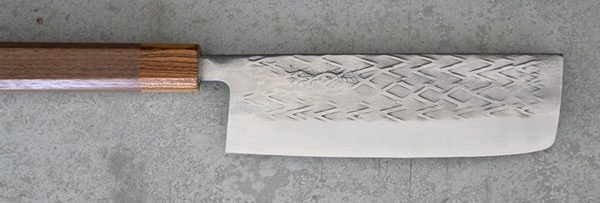17
Sep

Japanese knives are renowned worldwide for their sharpness, craftsmanship, and precision. When it comes to vegetables, these knives offer unmatched control. Using them, home cooks and professional chefs can prepare produce safely and efficiently.
Choosing the right knife can make a huge difference in the kitchen. No matter if you’re slicing tomatoes or creating detailed garnishes, Japanese vegetable knives will improve your experience. Here are the main types of Japanese vegetable knives to consider.

This is probably the most popular Japanese vegetable knife. It’s loved and appreciated for its precision and practicality. It has a straight, rectangular shape and a flat edge. Compared to Western-style chef’s knives, you don’t have to do the rocking motion to slice, dice, and chop vegetables. As a result, you get clean and even cuts that preserve the integrity of the veggies.
You can use the smooth and beautiful Nakiri knife to handle cucumbers, tomatoes, leafy greens, and even firmer veggies such as potatoes, carrots, and daikon radish. This knife was originally made to be used in Japanese households for vegetable prep. It was designed to make kitchen tasks safer and faster.
One of its biggest advantages is its lightweight construction. These knives have a thinner blade that’s responsible for precise cuts. This also prevents hand fatigue during long chopping sessions. Because of the flat edge, you can easily scoop the chopped vegetables and transfer them into a bowl or a pan. This is a very efficient way of working.
These knives can be made of several materials. The most common ones are high-carbon steel and stainless steel, and there are also laminated varieties. Some of them even feature decorative Damascus patterns. Blades made from high-carbon steel maintain their sharpness for a longer time. However, they need some maintenance to avoid rust.
Stainless steel is more forgiving and a much better choice for beginners. Make sure you wash it by hand and dry it immediately. Always use a soft cutting board because it’ll extend the knife’s lifespan and improve its performance. While this knife is designed specifically for chopping veggies, you can also use it to slice herbs, mince garlic, and handle soft fruits.
What makes this knife a favourite among both professionals and home cooks is the precision and control it provides. By investing in a quality knife like this, you not only get a tool that combines tradition and functionality but also a knife with a lot of elegance that can turn vegetable preparation into a smooth, enjoyable experience.
The Usuba is a professional-grade Japanese vegetable knife designed for ultra-precise cutting. It has a single-bevel edge, which means only one side of the blade is angled for slicing. Because of this design, you’ll get thin and uniform cuts. You can cut veggies in continuous sheets and make decorative garnishes if you want to accentuate your presentation.
Usuba knives have a long history in Japan. They’re often associated with the kaiseki cuisine, which is all about seasonal ingredients and a nice, precise presentation. Because of the thin, sharp blades, these knives need skill to handle them safely. In return, they give you the control to cut veggies without crushing them.
Care is essential for maintaining Usuba knives. They’re usually made of high-carbon steel and need to be hand washed and dried carefully. If you handle them properly, these knives will last for many years to come and give you the same perfect results each time. Both professionals and home cooks love these knives because of the balance, elegance, and precision.
The Santoku knife is a versatile, all-purpose knife that, besides vegetables, can also handle meat and fish. Compared to the Nakiri that has a flat blade, the Santoku has a slightly curved one. Because of this, it allows a rocking motion that makes slicing and chopping the ingredients more comfortable.
The broad blade also makes scooping and transferring chopped items simple, adding convenience to meal prep. This blade is perfect for slicing onions, bell peppers, or zucchini. It’s well-balanced and has a good weight distribution that prevents hand fatigue. These blades can be made of stainless steel or high-carbon steel.
Some of them have Granton edges to prevent the veggies from sticking to the blade. Because of their versatility, these knives are one of the favourites among home cooks. They can deliver professional results without a lot of effort. Just like the others, with proper care, you can have the Santoku knife for years to come.
Aokiri are also known as Kamo-style knives. They’re not that common or popular among home cooks but are highly appreciated by professionals. They’re specialised knives that are suitable for precise vegetable work. They combine the flat edge of the Nakiri knife with the thin blade of the Usuba, allowing chefs to create uniform cuts, paper-thin sheets, or decorative sticks.
That’s why they’re commonly used in professional kitchens where presentation is as important as flavour. They’re able to highlight the artistry of Japanese knife work. They need regular sharpening and proper and careful maintenance. If you do this right, they can be a reliable tool in the kitchen for many years.
Aokiri knives are perfect for chefs and cooking enthusiasts looking to elevate their vegetable preparation. Their design balances precision, beauty, and functionality, creating clean cuts and helping you make beautiful veggie decorations.
These knives combine beauty, precision, and practicality in one, so you get the best results in the kitchen. They’re great for chopping, creating delicate garnishes, decorative presentation, and much more. By understanding the differences between them, you can choose the right tool for every need. Investing in quality Japanese knives not only improves efficiency and safety but also transforms everyday vegetable preparation into an enjoyable and professional experience.